Info [wiki]
Superior acromio-clavicular ligament
Inferior acromio-clavicular ligament
coraco-clavicular ligament [wiki] (includes two fasciculi: trapezoid and conoid ligaments)
coraco-acromial ligament
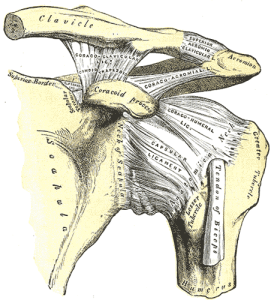
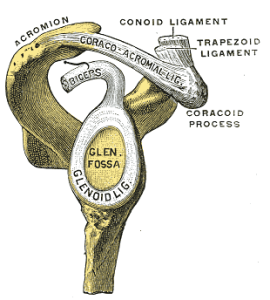
Shoulder Joint
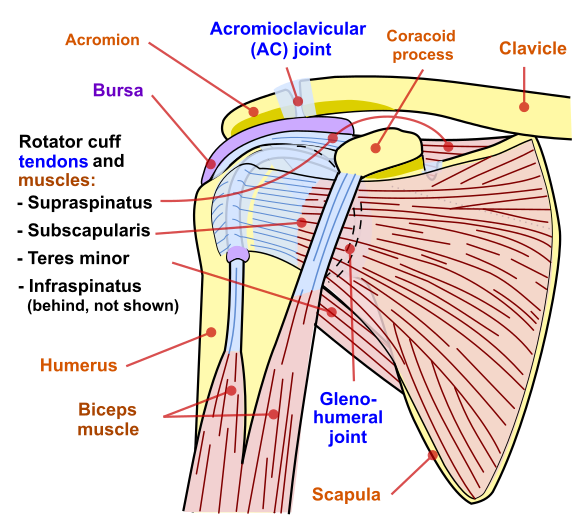
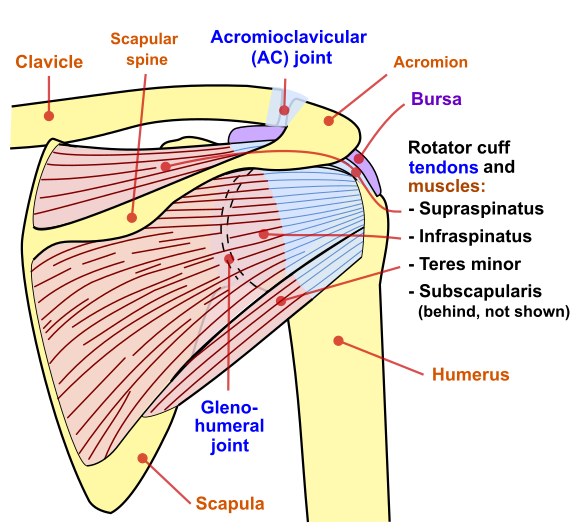
Cleveland Clinic
https://my.clevelandclinic.org/health/diseases/17909-separated-shoulder
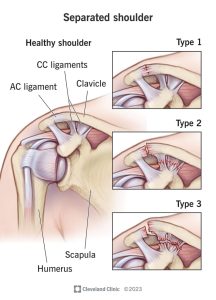
Acromium-Clavicle Joint (acromioclavicular joint)
Grades of shoulder separation
A shoulder separation can be mild to severe. Healthcare providers classify acromioclavicular joint separations based on the extent of your injury and how many ligaments are involved. Providers frequently use a rating system called the Rockwood classification of AC joint injuries, which includes:
- Type I: Your injury involves a sprain or partial tear of your acromioclavicular (AC) ligaments with no injury to additional ligaments that stabilize your clavicle, called coracoclavicular (CC) ligaments. You may have mild swelling and tenderness, but it should heal on its own within a few weeks.
- Type II: Your injury involves a complete tear of your AC ligaments and a sprain or partial tear of your CC ligaments. You may have mild tenderness and significant swelling.
- Type III: Your injury involves a complete tear of your AC and CC ligaments. Your AC joint may have a large bump but also have significant swelling, and your CC joint will be very tender.
- Type IV: Your injury involves torn ligaments, and your clavicle is pushed back behind your acromioclavicular joint. This is a fairly severe injury that may need surgery.
- Type V: Your injury involves torn ligaments, and the end of your clavicle punctures the muscle above your acromioclavicular joint. This is another severe injury that may require surgery.
- Type VI: Your injury involves torn ligaments, and your clavicle pushes downward and becomes lodged underneath your coracoid (part of your shoulder blade). This is a rare yet severe injury that requires surgery.
E3 Rehab
https://e3rehab.com/acromioclavicular-joint-injury/

There are 6 types:
Type 1 – involves a mild sprain of only the acromioclavicular ligament.
Type 2 – consists of a ruptured acromioclavicular ligament and joint capsule, and a mild sprain of the coracoclavicular ligament.
Type 3 – both ligaments and joint capsule are ruptured and the distal end of the clavicle is moderately elevated.
This type often presents with a piano key sign, where applying downward pressure on the distal clavicle causes temporary reduction. Upon releasing the pressure, the clavicle returns to an elevated position, similar to pressing a piano key.
Type 4 – presents similarly to type 3 but with a posteriorly displaced distal clavicle, possibly penetrating the trapezius muscle.
Type 5 – the distal clavicle is severely elevated and there is a high probability that both the deltoid and trapezius muscles are detached from the clavicle.
Type 6 – the distal end of the clavicle is inferiorly displaced under the coracoid process of the scapula (behind the coracobrachialis and short head of the biceps tendon).
Other Links
https://shoulderelbowsurgeon.co.uk/shoulder.html
http://www.guildfordupperlimb.co.uk/shoulder/acromio-clavicular-joint
https://www.acjointseparation.com/shoulder-separation-recovery-time/
https://www.healthline.com/health/ac-joint-surgery-success-rate
https://heidenortho.com/heal-ac-separation/
https://www.thesteadmanclinic.com/patient-education/shoulder/ac-separation
Leave a Reply